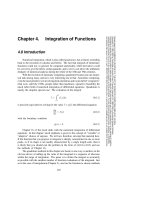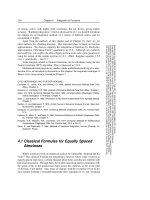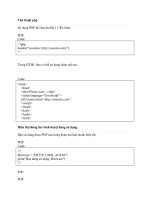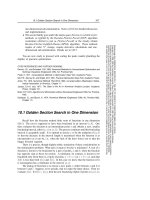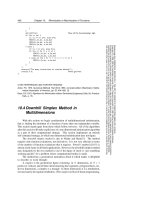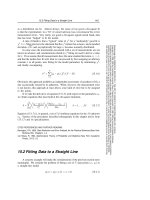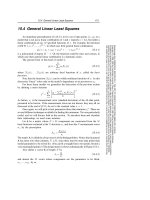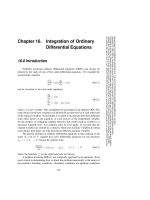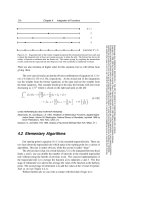Tài liệu Integration of Functions part 5 docx
Bạn đang xem bản rút gọn của tài liệu. Xem và tải ngay bản đầy đủ của tài liệu tại đây (170.12 KB, 7 trang )
4.4 Improper Integrals
141
Sample page from NUMERICAL RECIPES IN C: THE ART OF SCIENTIFIC COMPUTING (ISBN 0-521-43108-5)
Copyright (C) 1988-1992 by Cambridge University Press.Programs Copyright (C) 1988-1992 by Numerical Recipes Software.
Permission is granted for internet users to make one paper copy for their own personal use. Further reproduction, or any copying of machine-
readable files (including this one) to any servercomputer, is strictly prohibited. To order Numerical Recipes books,diskettes, or CDROMs
visit website or call 1-800-872-7423 (North America only),or send email to (outside North America).
which contain no singularities, and where the endpointsare also nonsingular. qromb,
in such circumstances, takes many, many fewer function evaluations than either of
the routines in §4.2. For example, the integral
2
0
x
4
log(x +
x
2
+1)dx
converges (with parameters as shown above) on the very first extrapolation, after
just 5 calls to trapzd, while qsimp requires 8 calls (8 times as many evaluations of
the integrand) and qtrap requires 13 calls (making 256 times as many evaluations
of the integrand).
CITED REFERENCES AND FURTHER READING:
Stoer, J., and Bulirsch, R. 1980,
Introduction to Numerical Analysis
(New York: Springer-Verlag),
§§
3.4–3.5.
Dahlquist, G., and Bjorck, A. 1974,
Numerical Methods
(Englewood Cliffs, NJ: Prentice-Hall),
§§
7.4.1–7.4.2.
Ralston, A., and Rabinowitz, P. 1978,
A First Course in Numerical Analysis
, 2nd ed. (New York:
McGraw-Hill),
§
4.10–2.
4.4 Improper Integrals
For our present purposes, an integral will be “improper” if it has any of the
following problems:
• its integrand goes to a finite limiting value at finite upper and lower limits,
but cannot be evaluated right on one of those limits(e.g., sin x/x at x =0)
• its upper limit is ∞ , or its lower limit is −∞
• it has an integrable singularity at either limit (e.g., x
−1/2
at x =0)
• it has an integrable singularity at a known place between its upper and
lower limits
• it has an integrable singularity at an unknown place between its upper
and lower limits
If an integral is infinite (e.g.,
∞
1
x
−1
dx), or does not exist in a limiting sense
(e.g.,
∞
−∞
cos xdx), we do not call it improper; we call it impossible. No amount of
clever algorithmics will return a meaningful answer to an ill-posed problem.
In this section we will generalize the techniques of the preceding two sections
to cover the first four problems on the above list. A more advanced discussion of
quadrature with integrable singularities occurs in Chapter 18, notably §18.3. The
fifth problem, singularity at unknown location, can really only be handled by the
use of a variable stepsize differential equation integration routine, as will be given
in Chapter 16.
We need a workhorse like the extended trapezoidal rule (equation 4.1.11), but
one which is an open formula in the sense of §4.1, i.e., does not require the integrand
to be evaluated at the endpoints. Equation (4.1.19), the extended midpoint rule, is
the best choice. The reason is that (4.1.19) shares with (4.1.11) the “deep” property
142
Chapter 4. Integration of Functions
Sample page from NUMERICAL RECIPES IN C: THE ART OF SCIENTIFIC COMPUTING (ISBN 0-521-43108-5)
Copyright (C) 1988-1992 by Cambridge University Press.Programs Copyright (C) 1988-1992 by Numerical Recipes Software.
Permission is granted for internet users to make one paper copy for their own personal use. Further reproduction, or any copying of machine-
readable files (including this one) to any servercomputer, is strictly prohibited. To order Numerical Recipes books,diskettes, or CDROMs
visit website or call 1-800-872-7423 (North America only),or send email to (outside North America).
of having an error series that is entirely even in h. Indeed there is a formula, not as
well known as it ought to be, called the Second Euler-Maclaurinsummation formula,
x
N
x
1
f(x)dx = h[f
3/2
+ f
5/2
+ f
7/2
+···+f
N−3/2
+f
N−1/2
]
+
B
2
h
2
4
(f
N
−f
1
)+···
+
B
2k
h
2k
(2k)!
(1 − 2
−2k+1
)(f
(2k−1)
N
− f
(2k−1)
1
)+···
(4.4.1)
This equation can be derived by writing out (4.2.1) with stepsize h, then writing it
out again with stepsize h/2, then subtracting the first from twice the second.
It is not possible to double the number of steps in the extended midpoint rule
and still have the benefit of previous function evaluations (try it!). However, it is
possible to triple the number of steps and do so. Shall we do this, or double and
accept the loss? On the average, tripling does a factor
√
3 of unnecessary work,
since the “right” number of steps for a desired accuracy criterion may in fact fall
anywhere in the logarithmic interval implied by tripling. For doubling, the factor
is only
√
2, but we lose an extra factor of 2 in being unable to use all the previous
evaluations. Since 1.732 < 2 × 1.414, it is better to triple.
Here is the resulting routine, which is directly comparable to trapzd.
#define FUNC(x) ((*func)(x))
float midpnt(float (*func)(float), float a, float b, int n)
This routine computes the
n
th stage of refinement of an extended midpoint rule.
func
is input
as a pointer to the function to be integrated between limits
a
and
b
, also input. When called with
n
=1, the routine returns the crudest estimate of
b
a
f(x)dx. Subsequent calls with
n
=2,3,...
(in that sequential order) will improve the accuracy of
s
by adding (2/3) × 3
n-1
additional
interior points.
s
should not be modified between sequential calls.
{
float x,tnm,sum,del,ddel;
static float s;
int it,j;
if (n == 1) {
return (s=(b-a)*FUNC(0.5*(a+b)));
} else {
for(it=1,j=1;j<n-1;j++) it *= 3;
tnm=it;
del=(b-a)/(3.0*tnm);
ddel=del+del; The added points alternate in spacing between
del and ddel.x=a+0.5*del;
sum=0.0;
for (j=1;j<=it;j++) {
sum += FUNC(x);
x += ddel;
sum += FUNC(x);
x += del;
}
s=(s+(b-a)*sum/tnm)/3.0; The new sum is combined with the old integral
to give a refined integral.return s;
}
}
4.4 Improper Integrals
143
Sample page from NUMERICAL RECIPES IN C: THE ART OF SCIENTIFIC COMPUTING (ISBN 0-521-43108-5)
Copyright (C) 1988-1992 by Cambridge University Press.Programs Copyright (C) 1988-1992 by Numerical Recipes Software.
Permission is granted for internet users to make one paper copy for their own personal use. Further reproduction, or any copying of machine-
readable files (including this one) to any servercomputer, is strictly prohibited. To order Numerical Recipes books,diskettes, or CDROMs
visit website or call 1-800-872-7423 (North America only),or send email to (outside North America).
The routine midpnt can exactly replace trapzd in a driver routine like qtrap
(§4.2); one simply changes trapzd(func,a,b,j) to midpnt(func,a,b, j),and
perhaps also decreases the parameter JMAX since 3
JMAX
−1
(from step tripling) is a
much larger number than 2
JMAX
−1
(step doubling).
The open formula implementation analogous to Simpson’s rule (qsimp in §4.2)
substitutes midpnt for trapzd and decreases JMAX as above, but now also changes
the extrapolation step to be
s=(9.0*st-ost)/8.0;
since, when the number of steps is tripled, the error decreases to 1/9th its size, not
1/4th as with step doubling.
Either the modified qtrap or the modified qsimp will fix the first problem
on the list at the beginning of this section. Yet more sophisticated is to generalize
Romberg integration in like manner:
#include <math.h>
#define EPS 1.0e-6
#define JMAX 14
#define JMAXP (JMAX+1)
#define K 5
float qromo(float (*func)(float), float a, float b,
float (*choose)(float(*)(float), float, float, int))
Romberg integration on an open interval. Returns the integral of the function
func
from
a
to
b
,
using any specified integrating function
choose
and Romberg’s method. Normally
choose
will
be an open formula, not evaluating the function at the endpoints. It is assumed that
choose
triples the number of steps on each call, and that its error series contains only even powers of
the number of steps. The routines
midpnt
,
midinf
,
midsql
,
midsqu
,
midexp
, are possible
choices for
choose
. The parameters have the same meaning as in
qromb
.
{
void polint(float xa[], float ya[], int n, float x, float *y, float *dy);
void nrerror(char error_text[]);
int j;
float ss,dss,h[JMAXP+1],s[JMAXP];
h[1]=1.0;
for (j=1;j<=JMAX;j++) {
s[j]=(*choose)(func,a,b,j);
if (j >= K) {
polint(&h[j-K],&s[j-K],K,0.0,&ss,&dss);
if (fabs(dss) <= EPS*fabs(ss)) return ss;
}
h[j+1]=h[j]/9.0; This is where the assumption of step tripling and an even
error series is used.}
nrerror("Too many steps in routing qromo");
return 0.0; Never get here.
}
Don’t be put off by qromo’s complicated ANSI declaration. A typical invocation
(integrating the Bessel function Y
0
(x) from 0 to 2) is simply
#include "nr.h"
float answer;
...
answer=qromo(bessy0,0.0,2.0,midpnt);
144
Chapter 4. Integration of Functions
Sample page from NUMERICAL RECIPES IN C: THE ART OF SCIENTIFIC COMPUTING (ISBN 0-521-43108-5)
Copyright (C) 1988-1992 by Cambridge University Press.Programs Copyright (C) 1988-1992 by Numerical Recipes Software.
Permission is granted for internet users to make one paper copy for their own personal use. Further reproduction, or any copying of machine-
readable files (including this one) to any servercomputer, is strictly prohibited. To order Numerical Recipes books,diskettes, or CDROMs
visit website or call 1-800-872-7423 (North America only),or send email to (outside North America).
The differences between qromo and qromb (§4.3) are so slight that it is perhaps
gratuitousto list qromo in full. It, however, is an excellent driver routine for solving
all the other problems of improper integrals in our first list (except the intractable
fifth), as we shall now see.
The basic trick for improper integrals is to make a change of variables to
eliminate the singularity, or to map an infinite range of integration to a finite one.
For example, the identity
b
a
f(x)dx =
1/a
1/b
1
t
2
f
1
t
dt ab > 0(4.4.2)
can be used with either b →∞and a positive, or with a →−∞and b negative, and
works for any function which decreases towards infinity faster than 1/x
2
.
You can make the change of variable implied by (4.4.2) either analytically and
then use (e.g.) qromo and midpnt to do the numerical evaluation, or you can let
the numerical algorithm make the change of variable for you. We prefer the latter
method as being more transparent to the user. To implement equation (4.4.2) we
simply write a modified version of midpnt, called midinf, which allows b to be
infinite (or, more precisely, a very large number on your particular machine, such
as 1 × 10
30
), or a to be negative and infinite.
#define FUNC(x) ((*funk)(1.0/(x))/((x)*(x))) Effects the change of variable.
float midinf(float (*funk)(float), float aa, float bb, int n)
This routine is an exact replacement for
midpnt
, i.e., returns the
n
th stage of refinement of
the integral of
funk
from
aa
to
bb
, except that the function is evaluated at evenly spaced
points in 1/x rather than in x. This allows the upper limit
bb
to be as large and positive as
the computer allows, or the lower limit
aa
to be as large and negative, but not both.
aa
and
bb
must have the same sign.
{
float x,tnm,sum,del,ddel,b,a;
static float s;
int it,j;
b=1.0/aa; These two statements change the limits of integration.
a=1.0/bb;
if (n == 1) { From this point on, the routine is identical to midpnt.
return (s=(b-a)*FUNC(0.5*(a+b)));
} else {
for(it=1,j=1;j<n-1;j++) it *= 3;
tnm=it;
del=(b-a)/(3.0*tnm);
ddel=del+del;
x=a+0.5*del;
sum=0.0;
for (j=1;j<=it;j++) {
sum += FUNC(x);
x += ddel;
sum += FUNC(x);
x += del;
}
return (s=(s+(b-a)*sum/tnm)/3.0);
}
}
4.4 Improper Integrals
145
Sample page from NUMERICAL RECIPES IN C: THE ART OF SCIENTIFIC COMPUTING (ISBN 0-521-43108-5)
Copyright (C) 1988-1992 by Cambridge University Press.Programs Copyright (C) 1988-1992 by Numerical Recipes Software.
Permission is granted for internet users to make one paper copy for their own personal use. Further reproduction, or any copying of machine-
readable files (including this one) to any servercomputer, is strictly prohibited. To order Numerical Recipes books,diskettes, or CDROMs
visit website or call 1-800-872-7423 (North America only),or send email to (outside North America).
If you need to integrate from a negative lower limit to positive infinity, you do
this by breaking the integral into two pieces at some positive value, for example,
answer=qromo(funk,-5.0,2.0,midpnt)+qromo(funk,2.0,1.0e30,midinf);
Where should you choose the breakpoint? At a sufficiently large positive value so
that the function funk is at least beginning to approach its asymptotic decrease to
zero value at infinity. The polynomial extrapolation implicit in the second call to
qromo deals with a polynomial in 1/x, not in x.
To deal with an integral that has an integrable power-law singularity at its lower
limit, one also makes a change of variable. If the integrand diverges as (x − a)
γ
,
0 ≤ γ<1, near x = a, use the identity
b
a
f(x)dx =
1
1 − γ
(b−a)
1−γ
0
t
γ
1−γ
f(t
1
1−γ
+ a)dt (b>a)(4.4.3)
If the singularity is at the upper limit, use the identity
b
a
f(x)dx =
1
1 − γ
(b−a)
1−γ
0
t
γ
1−γ
f(b − t
1
1−γ
)dt (b>a)(4.4.4)
If there is a singularity at both limits, divide the integral at an interior breakpoint
as in the example above.
Equations (4.4.3) and (4.4.4) are particularly simple in the case of inverse
square-root singularities, a case that occurs frequently in practice:
b
a
f(x)dx =
√
b−a
0
2tf(a + t
2
)dt (b>a)(4.4.5)
for a singularity at a,and
b
a
f(x)dx =
√
b−a
0
2tf(b − t
2
)dt (b>a)(4.4.6)
for a singularity at b. Once again, we can implement these changes of variable
transparently to the user by defining substitute routines for midpnt which make the
change of variable automatically:
#include <math.h>
#define FUNC(x) (2.0*(x)*(*funk)(aa+(x)*(x)))
float midsql(float (*funk)(float), float aa, float bb, int n)
This routine is an exact replacement for
midpnt
, except that it allows for an inverse square-root
singularity in the integrand at the lower limit
aa
.
{
float x,tnm,sum,del,ddel,a,b;
static float s;
int it,j;
b=sqrt(bb-aa);
a=0.0;
if (n == 1) {
The rest of the routine is exactly like
midpnt
and is omitted.
